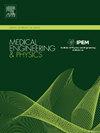利用治疗性聚焦换能器的回声振幅监测聚焦超声消融手术(FUAS)
IF 1.7
4区 医学
Q3 ENGINEERING, BIOMEDICAL
引用次数: 0
摘要
目的B型超声造影通常用于监测聚焦超声消融手术(FUAS),但在灵敏度方面存在局限性。方法 对聚焦超声(FUS)换能器进行改装,使其能够接收回波。数值模拟比较了 FUS 换能器和成像探头在不同组织深度和频率下的归一化回波振幅,病灶处有 3 毫米坏死。然后进行了一次体内实验,评估了不同设置下 FUS 传感器和超声成像探头的回声变化。结果与超声成像探头相比,随着组织穿透深度的增加,FUS 换能器产生的回声振幅下降不那么明显。在深度为 2 厘米和 4 厘米的体外牛肝实验中,FUS 传感器检测到的归一化回波振幅明显大于超声成像探头接收到的回波振幅(即 2∼3 倍)。此外,复制临床条件的多层体外组织实验显示,利用 FUS 传感器的回波振幅进行凝血预测的准确性(91.2% 对 60.3%)、灵敏度(92.1% 对 54.5%)和阴性预测(78.结论 FUS 传感器的回声振幅是监测 FUAS 结果的灵敏可靠的指标。利用它可以提高手术的安全性和有效性。本文章由计算机程序翻译,如有差异,请以英文原文为准。
Monitoring focused ultrasound ablation surgery (FUAS) using echo amplitudes of the therapeutic focused transducer
Objective
B-mode sonography is commonly used to monitor focused ultrasound ablation surgery (FUAS), but has limitations in sensitivity. More accurate and reliable prediction of coagulation is required.
Methods
The focused ultrasound (FUS) transducer was adapted for echo reception. Numerical simulations compared the normalized echo amplitudes from the FUS transducer and imaging probe at varying tissue depths and frequencies with a 3 mm necrosis at focus. An ex vivo experiment then evaluated echo changes from the FUS transducer and ultrasound imaging probe under different settings. Finally, coagulation prediction using FUS echo data was compared to sonography in a clinical ex vivo context.
Results
The echo amplitudes from the FUS transducer exhibit a less pronounced decline with increasing tissue penetration depth compared to the ultrasound imaging probe. In ex vivo bovine liver experiments at depths of 2 cm and 4 cm, the FUS transducer detected normalized echo amplitudes that were significantly larger (i.e., 2∼3 folds) than those received by the ultrasound imaging probe. Moreover, multi-layered ex vivo tissue experiments that replicate clinical conditions revealed that coagulation prediction utilizing the FUS transducer's echo amplitudes achieved superior accuracy (91.2% vs. 60.3 %), sensitivity (92.1% vs. 54.5 %), and negative prediction (78.9% vs. 30.6 %), but similar specificity (88.2% vs. 84.6 %) and positive prediction (95.9% vs. 93.8 %) in comparison to sonography.
Conclusion
The echo amplitude of the FUS transducer serves as a sensitive and dependable metric for monitoring the FUAS outcomes. Its utilization may augment the procedure's safety and efficacy.
求助全文
通过发布文献求助,成功后即可免费获取论文全文。
去求助
来源期刊

Medical Engineering & Physics
工程技术-工程:生物医学
CiteScore
4.30
自引率
4.50%
发文量
172
审稿时长
3.0 months
期刊介绍:
Medical Engineering & Physics provides a forum for the publication of the latest developments in biomedical engineering, and reflects the essential multidisciplinary nature of the subject. The journal publishes in-depth critical reviews, scientific papers and technical notes. Our focus encompasses the application of the basic principles of physics and engineering to the development of medical devices and technology, with the ultimate aim of producing improvements in the quality of health care.Topics covered include biomechanics, biomaterials, mechanobiology, rehabilitation engineering, biomedical signal processing and medical device development. Medical Engineering & Physics aims to keep both engineers and clinicians abreast of the latest applications of technology to health care.
 求助内容:
求助内容: 应助结果提醒方式:
应助结果提醒方式:


